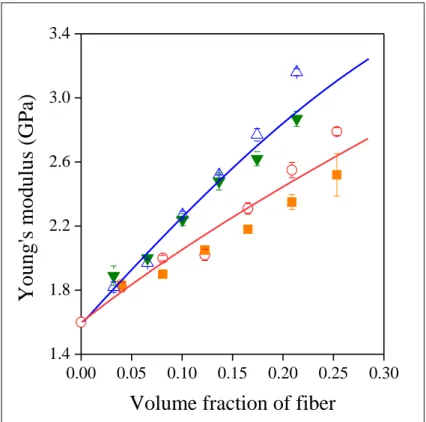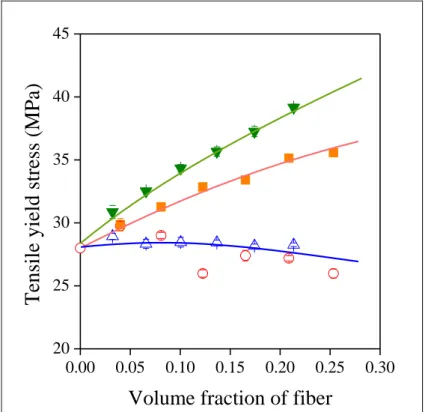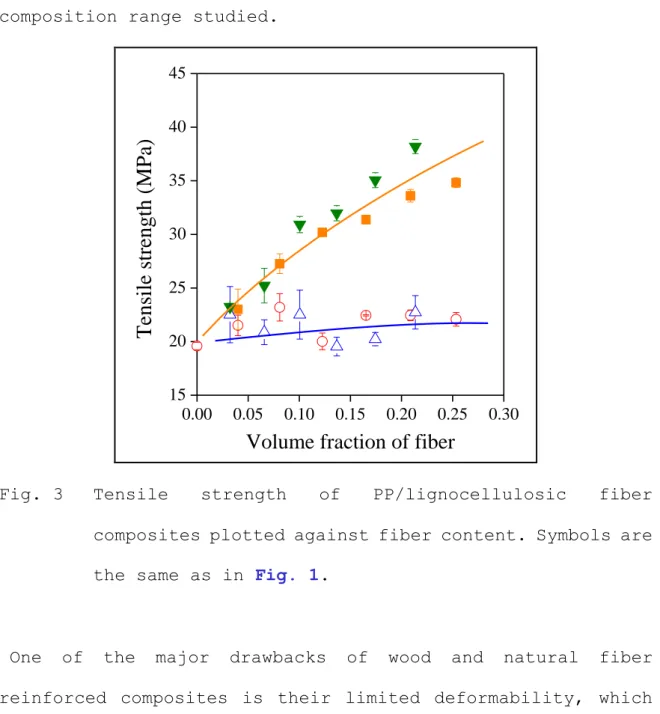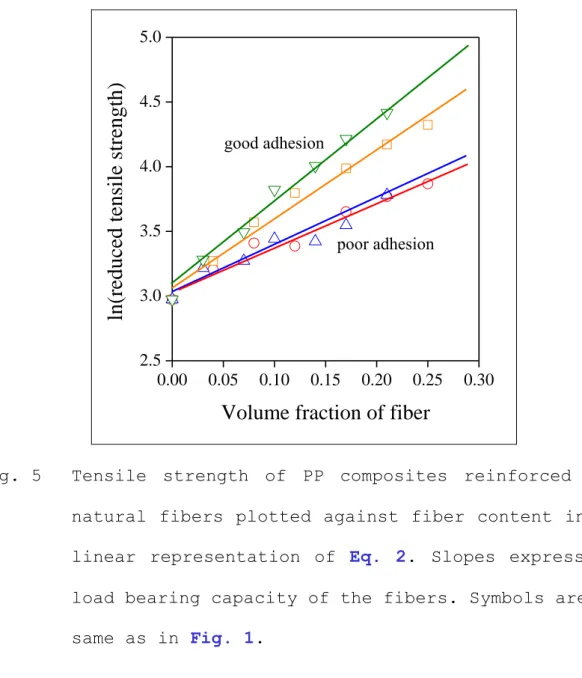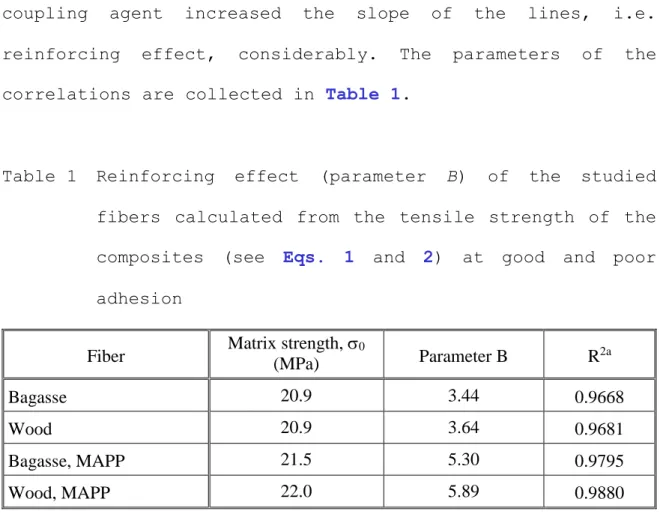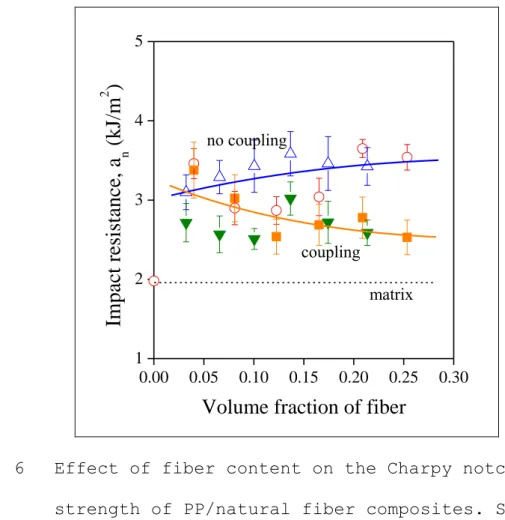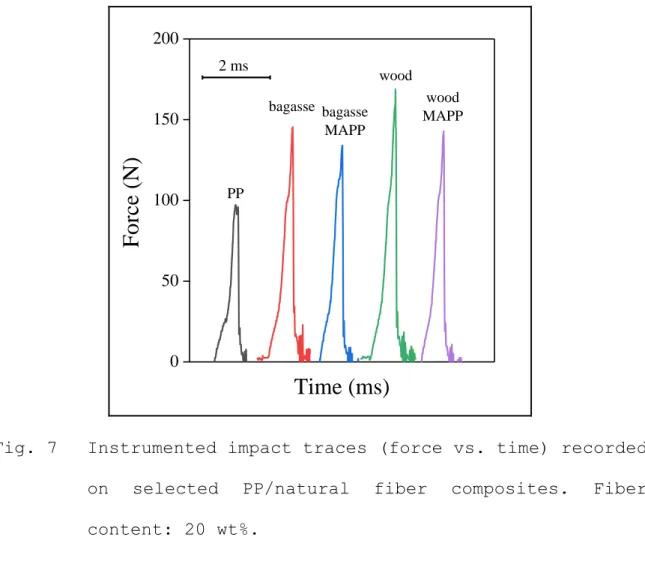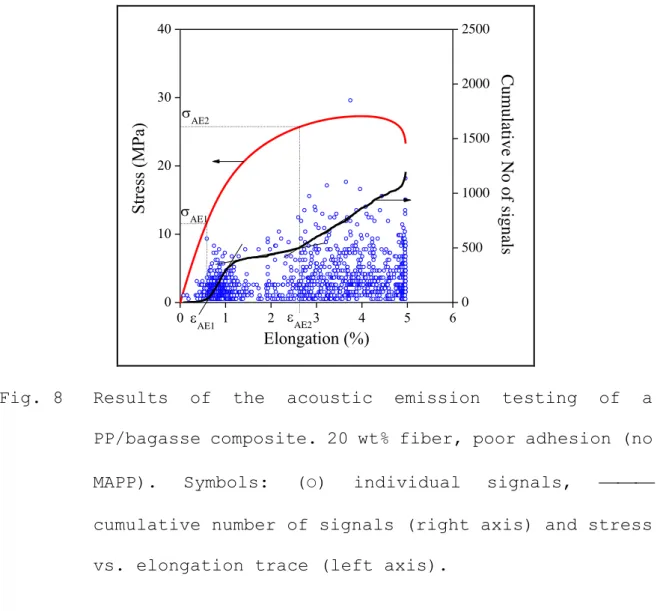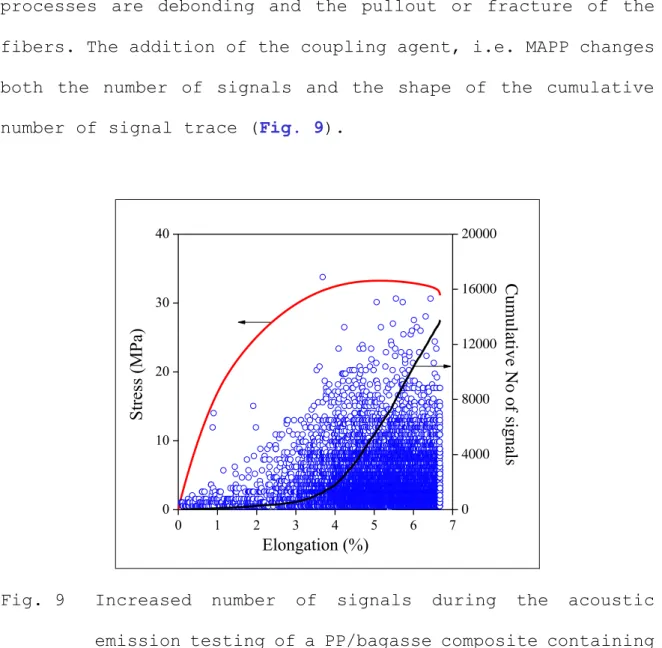EUROPEAN POLYMER JOURNAL
VOLUME 112, MARCH 2019, PAGES 153-160 https://doi.org/10.1016/j.eurpolymj.2018.12.033
DEFORMATION AND FAILURE OF SUGARCANE BAGASSE REINFORCED PP
Juliana Anggono1, Ágnes Elvira Farkas2,3, András Bartos2,3, János Móczó2,3,*, Antoni4, Hariyati Purwaningsih5, Béla
Pukánszky2,3
1Mechanical Engineering Department, Petra Christian University, Jalan Siwalankerto 121-131, Surabaya 60236, Indonesia
2Institute of Materials and Environmental Chemistry, Research Centre for Natural Sciences, Hungarian Academy of Sciences, H-1519 Budapest, P.O. Box 286, Hungary
3Laboratory of Plastics and Rubber Technology, Department of Physical Chemistry and Materials Science, Budapest University of Technology and Economics, H-1521 Budapest, P.O. Box 91, Hungary
4Civil Engineering Department, Petra Christian University, Jalan Siwalankerto 121-131, Surabaya 60236, Indonesia
5Materials and Metallurgical Engineering Department, Sepuluh Nopember Institute of Technology, Jalan Raya ITS Keputih Sukolilo, Surabaya 60111, Indonesia
*Corresponding author: János Móczó, Tel: +36-1-383-6569, Fax:
+36-1-463-3474, E-mail: jmoczo@mail.bme.hu
2 ABSTRACT
Polypropylene composites were prepared from sugarcane bagasse fibers by extrusion and injection molding. Wood flour was used as reference filler in the study. The fiber content of the composites changed between 0 and 30 wt% in 5 wt% steps.
Maleated polypropylene was used as coupling agent to improve interfacial adhesion. Mechanical properties were characterized by tensile and fracture testing, while local deformation processes were followed by acoustic emission and instrumented impact testing, as well as by the analysis of scanning electron micrographs. The results showed that sugarcane bagasse fibers reinforce polypropylene similarly to other natural fibers. They increases stiffness, but decrease tensile yield stress, tensile strength and deformability.
Increased interfacial adhesion leads to the considerable improvement of reinforcement. Bagasse fiber and wood flour filled composites have very similar properties. The impact resistance of the composites increased in the presence of both fibers compared to the neat matrix. Debonding is the dominating process in the absence of the coupling agent, while mainly fiber fracture occurs in its presence. Increased plastic deformation after debonding results in slightly improved impact resistance.
3 Keywords: natural fiber reinforcement, mechanical properties, fracture resistance, instrumented impact testing, interfacial adhesion, local deformation processes
1. INTRODUCTION
The use of natural resources increases continuously in all areas of our life. The number of possible raw materials produced by nature is enormous and we use only a small fraction presently. The increase of interest in natural materials is driven by the improving environmental awareness of the public, but also by other factors. Natural fibers are extensively used in the automotive and building industry already now and further increase is expected in the future [1-9]. Natural fibers have many advantages, such as abundant source, low price, but these fibers are also light, thus their use reduces the weight of the vehicles [4-6,10-12]. Reduced weight results in decreased fuel consumption and smaller emission [6,10-13].
The fibers used in the largest quantity are flax, hemp and kenaf, but a number of other fibers like bamboo, ramie, sisal, coir and wood flour are also applied for various purposes such as inner door panel, under body cover, seat backs, ceiling liner, etc. [4,5,11,12,14-18]. Natural fibers have numerous advantages, but also a few drawbacks like sensitivity to moisture [11,12,16], small transverse strength, variability in properties, etc. [19].
4 The properties of heterogeneous polymers including fiber- reinforced composites are determined by four factors, by component properties, composition, structure and interfacial interactions [20]. In the case of wood flour and other natural fibers, the main factor proved to be the size and aspect ratio of the particles [21]. Larger aspect ratio improves stress transfer and reinforcement, but it makes processing more difficult [21]. The surface energy of natural fibers is small, thus their adhesion to the polymer matrix is weak, especially in polyolefins, which do not contain any polar functional groups [16,22,23]. Interfacial interactions may be stronger if the polymer contains groups capable of forming specific interactions, e.g. hydrogen bonds, like in poly(lactic acid) (PLA), for example [24]. In the case of large particles, the transvers strength, i.e. the strength of the fiber vertically to its axis, proved to be small, which led to small tensile strength and impact resistance [21]. Various fibers coming from a variety of sources can have a wide range of characteristics and thus the properties of the composites prepared from them can vary considerably [16,25].
One of the advantages of natural fibers is that they are cheap, especially if they are obtained from local resources very often as waste [14,26-31], which further decreases their price. Using local resources is extremely important in developing societies in which the value added application of
5 cheap natural resources can improve economy considerably [14].
Indonesia is an agricultural country producing considerable amounts of coconut, rubber, coffee, tea, tobacco, but also sugar. The fibers from the sugarcane bagasse form a waste, which is burnt to produce energy for the production of the sugar. With the intensification and modernization of the processes, this energy source becomes superfluous and the bagasse generates waste, which must be handled in a different, but environmentally friendly and economically advantageous way. A possible approach for the value added application of fibers from sugarcane bagasse is their use as reinforcements in polymer composites.
Accordingly, the goal of the present project was to explore the possibility of using sugarcane bagasse fibers as reinforcement for polypropylene. We prepared composites with various fiber contents in order to determine the effect of composition on composite properties. PP/wood composites were also prepared to use them as reference. In the study, we focused on the analysis of deformation processes and the mechanism of failure in order to find ways to improve properties, if necessary. The potentials of the fibers for practical applications are also considered briefly in the final part of the paper.
6 2. EXPERIMENTAL
2.1. Materials
The polypropylene used as matrix for the composites was the Tipplen H 649 FH grade homopolymer produced by the MOL Group Ltd., Hungary. The polymer has a nominal density of 0.9 g/cm3 and a melt flow rate of 2.5 g/10 min at 230 °C and 2.16 kg load. The bagasse fibers were obtained directly from the sugar mill. They were cleaned, dried, cut up and sieved. Two fractions were obtained a fibrous and a powdery. The fibrous fraction was used in the present experiments. The average particle size of the fibers was determined from scanning electron micrographs. The average length of the fibers was 4560 1870 m, while their average diameter was 340 156 m.
The wood flour used as reference was the Filtracell EFC 1000 grade produced by Rettenmaier and Söhne GmbH, Germany. The average length of the fibers was 363 136 m, while their average diameter was 64 11 m. A polypropylene functionalized with maleic anhydride was used as coupling agent. The Scona TPPP 2112 FA grade maleated PP (MAPP) was supplied by Byk- Chemie GmbH, Germany, and it had a melt flow rate of 2-7 g/10 min at 190 °C and 2.16 kg, and a maleic anhydride content of 0.9-1.2 % according to the data sheet of the producer. The fiber content of the composites changed from 0 to 30 wt% in 5 wt% steps. The ratio of MAPP/fiber was 0.1 in all composites.
2.2. Sample preparation
7 The fibers and the polymer were homogenized in a twin- screw compounder (Brabender DSK 42/7, Brabender, Germany) at set temperatures of 170-180-185-190 °C and 40 rpm. The fibers were dried before extrusion at 105 °C for 4 hours. Extrusion was repeated twice in order to increase homogeneity. The granulated composites were injection molded into standard (ISO 527 1A) tensile bars of 4 mm thickness using a Demag IntElect 50/330-100 machine. Processing parameters were 40-170-180- 185-190 °C set temperatures, 300-700 bar injection pressure, 50 bar back pressure, 50 mm/s injection speed, 25 s holding time, and 30 s cooling time. The specimens were stored at ambient temperature (25 °C, 50 % RH) for a week before further testing.
3.3. Characterization, measurements
The mechanical properties were characterized by tensile and impact testing. Tensile tests were carried out using an Instron 5566 universal testing machine with a gauge length of 115 mm and 5 mm/min crosshead speed. Modulus, yield properties (yield stress and yield strain), tensile strength and elongation-at-break were derived from recorded stress vs.
strain traces. Local deformation processes were followed by acoustic emission testing. Acoustic emission (AE) signals were recorded with a Sensophone AED 404 apparatus. A single a11 resonance detector with the resonance frequency of 150 kHz was
8 attached to the center of the specimen. The threshold level of detection was set to 23 dB. Impact resistance was characterized by the notched Charpy impact strength, which was determined according to the ISO 179 standard at 23 °C with 2 mm notch depth. Instrumented impact testing was carried out using a Ceast Resil 5.5 instrument (CEAST spa, Pianezza, Italy) with a 4 J hammer. The particle characteristics of the fibers as well as the appearance of broken surfaces were studied by scanning electron microscopy (Jeol JSM 6380 LA, Jeol Ltd., Tokyo, Japan). Micrographs were recorded on fracture surfaces created during tensile and fracture testing, respectively.
3. RESULTS AND DISCUSSION
Fiber reinforced composites are used as structural materials. Their most important properties are stiffness, strength and impact resistance. Overall mechanical properties of composites are determined by local deformation processes.
Accordingly, we discuss tensile properties and reinforcement in the first two sections of the paper. Subsequently we focus on fracture behavior and the analysis of local processes in the next two. Finally, structure-property correlations are discussed in the last section of the paper with some reference to practical consequences.
9 3.1. Tensile properties
0.00 0.05 0.10 0.15 0.20 0.25 0.30 1.4
1.8 2.2 2.6 3.0 3.4
Young's m odulus (GPa)
Volume fraction of fiber
Fig. 1 Composition dependence of the stiffness of PP/natural fiber composites prepared with bagasse fibers and wood flour as reference. Symbols: () bagasse, () bagasse, MAPP, () wood flour, () wood flour, MAPP.
The main role of reinforcing fibers is to increase the stiffness and the strength of the polymer used as matrix. The Young's modulus of polypropylene reinforced with the two types of fibers is plotted against fiber content in Fig. 1. Previous experience indicates that stiffness does not depend on fiber characteristics and adhesion very much, but mainly on the amount of fiber added to the matrix [21, 32]. The presence of MAPP does not influence stiffness indeed, but fiber
10 characteristics seem to have an effect [32]; the modulus of composites containing the bagasse fibers is smaller than that prepared with wood flour. Only one plausible explanation exist for this phenomenon, the bagasse fibers with their extremely large size debond from the matrix already at the very small deformations of the modulus determination, voids form, which decrease modulus. We must also note that the gradient of the modulus vs. fiber content correlations decrease with increasing fiber loadings. This effect indicates the presence of some structural factor, either the fibers abut each other forming associations [33] or their average orientation decreases with increasing fiber content. Such a change in orientation with filler content was observed earlier [34].
Tensile yield stress is plotted against fiber content in Fig. 2. The difference in the reinforcing effect of the two fibers, bagasse and wood, remained the same, but the influence of interfacial adhesion is much larger than in the case of stiffness. Several studies proved earlier that tensile characteristics determined at larger deformations depend much more on interfacial adhesion than stiffness [21, 32, 33]. It is interesting to note, that the effect of different particle characteristics does not appear in yield stress at poor adhesion, possibly because of the large size of the two fibers.
Although wood is much smaller than the bagasse fiber, but 210
m is still much larger than the usual size of mineral fillers,
11 which is in the micron range. The structural effect mentioned above affects properties also in this case and the effect can be seen in the composition dependence of yield stress. We much emphasize here, however, that both wood and bagasse reinforce PP at good adhesion.
0.00 0.05 0.10 0.15 0.20 0.25 0.30 20
25 30 35 40 45
Tensil e yiel d stress ( MPa)
Volume fraction of fiber
Fig. 2 Effect of fiber content on the tensile yield stress of PP/fiber composites. Influence of interfacial adhesion. Symbols are the same as in Fig. 1.
The tensile strength of the composites is presented as a function of fiber content in Fig. 3. Quite surprisingly, the differences in particle characteristics are even less visible than in the case of tensile yield stress. One reason might be the attrition of long fibers, but more probably the extensive
12 debonding of large particles that dominates local deformation.
On the other hand, the effect of adhesion on reinforcement is significant in this case; strength almost doubles in the composition range studied.
0.00 0.05 0.10 0.15 0.20 0.25 0.30 15
20 25 30 35 40 45
Tensil e strength (MPa)
Volume fraction of fiber
Fig. 3 Tensile strength of PP/lignocellulosic fiber composites plotted against fiber content. Symbols are the same as in Fig. 1.
One of the major drawbacks of wood and natural fiber reinforced composites is their limited deformability, which results in very rigid materials with small impact resistance.
As shown by Fig. 4, the elongation-at-break values of the composites decrease considerably with increasing fiber content to very small values. Hardly any difference can be made among
13 the composites in this respect, composites containing wood might have slightly larger deformability, and adhesion seems to decrease elongation, but the differences are very small.
The results presented above clearly show that the fibers applied in this study can be used in practice only when a coupling agent is added to improve adhesion and that the deformability of the composites is small.
0.00 0.05 0.10 0.15 0.20 0.25 0.30 0
10 20 30 40 50
bagasse
bagasse, MAPP wood
wood, MAPP
El ongati on-at-break ( %)
Volume fraction of fiber
Fig. 4 Decreasing elongation-at-break values of PP/natural fiber composites with increasing fiber content.
Symbols are the same as in Fig. 1.
3.2. Reinforcement
A general, qualitative idea can be obtained about the reinforcing effect of the two fibers from Figs. 2 and 3
14 presented above. However, it is very difficult to draw conclusions from those figures about reinforcement and it is impossible to estimate it quantitatively. A model is needed in order to determine the reinforcing effect of fibers more accurately. Such a model was developed earlier for the description of the tensile and impact characteristics of heterogeneous materials [35]. Eq. 1 describes the composition dependence of tensile strength in the following way
𝜎𝑇 = 𝜎𝑇0 𝜆𝑛 1 − 𝜑𝑓
1 + 2.5 𝜑𝑓 exp(𝐵 𝜑𝑓) (1)
where T and T0 are the true tensile strength of the composite and the matrix, respectively, f is the volume fraction of the fiber in the composite, B expresses the load bearing capacity of the fiber and it depends on interfacial adhesion. In the equation true tensile strength (T = , = L/L0, relative elongation) accounts for the change in specimen cross-section and n for strain hardening occurring with increasing elongation. n characterizes the strain hardening tendency of the polymer and can be determined from matrix properties. The rearrangement of the equation leads to the reduced tensile strength
𝜎𝑇𝑟𝑒𝑑 = 𝜎𝑇 𝜆𝑛
1 + 2.5 𝜑𝑓
1 − 𝜑𝑓 = 𝜎𝑇0 exp(𝐵 𝜑𝑓) (2)
and if we plot its natural logarithm against composition, we
15 should obtain straight lines, the slope of which expresses the reinforcing effect of the fibers quantitatively.
0.00 0.05 0.10 0.15 0.20 0.25 0.30 2.5
3.0 3.5 4.0 4.5 5.0
ln(reduced tensil e strength)
Volume fraction of fiber
poor adhesion good adhesion
Fig. 5 Tensile strength of PP composites reinforced with natural fibers plotted against fiber content in the linear representation of Eq. 2. Slopes express the load bearing capacity of the fibers. Symbols are the same as in Fig. 1.
The tensile strength of the four sets of composites is plotted in the way dictated by Eq. 2 in Fig. 5. Straight lines are obtained indeed with smaller or larger deviations from the line. Fiber characteristics do not seem to influence reinforcement much, the points for the two fillers fall on the same line, but interfacial adhesion does. The addition of the
16 coupling agent increased the slope of the lines, i.e.
reinforcing effect, considerably. The parameters of the correlations are collected in Table 1.
Table 1 Reinforcing effect (parameter B) of the studied fibers calculated from the tensile strength of the composites (see Eqs. 1 and 2) at good and poor adhesion
Fiber Matrix strength, 0
(MPa) Parameter B R2a
Bagasse 20.9 3.44 0.9668
Wood 20.9 3.64 0.9681
Bagasse, MAPP 21.5 5.30 0.9795
Wood, MAPP 22.0 5.89 0.9880
a) Determination coefficient indicating the accuracy of the fit.
The conclusions drawn from the direct observation of Fig. 5 are expressed quantitatively by the numbers in the table.
Small differences can be seen in the slope of the lines for the composites prepared with the different fibers, but much larger as an effect of improved adhesion. Fig. 5 calls attention to another fact. The model applied assumes the homogeneous distribution of the heterogeneous phase in a matrix. If structural phenomena occur (changing orientation, aggregation) in the composites, the points deviate from the
17 straight line. On closer scrutiny only slight deviation from linearity can be seen for the composites with good adhesion, i.e. which contain MAPP, thus our earlier assumption about the development of a special structure (fiber association) or the change of some structural factor (orientation) is not fully justified. Even if such phenomena exist, their effect on properties is small.
3.3. Fracture resistance
Impact strength is often a very important property for materials used in structural applications. Because of the dynamic conditions of testing, its composition dependence often differs considerably from that of tensile properties.
The impact resistance of the composites is plotted against fiber content in Fig. 6. The standard deviation of the measurement is quite large, but some conclusion can be drawn from the data quite unambiguously. First of all, the impact strength of all composites is larger than that of the matrix.
One of the major problems of wood reinforced composites is their limited impact strength, which cannot be improved in any way [36]. The only reasonable explanation for the phenomena is that local deformation processes occurring around the fibers during fracture absorb some energy, which increases impact strength. The other observation, which can be made, is that impact resistance increases slightly in the absence of
18 the coupling agent, i.e. in the case of poor adhesion, while it decreases when the coupling agent is present. Obviously, the deformation process resulting in the absorption of energy is hindered by the presence of the coupling agent, by strong adhesion. It must be emphasized here, though, that although the fibers increased fracture resistance compared to the matrix, the absolute value of impact strength is still small, the largest values are around 3.5 kJ/m2. At least 15 kJ/m2 impact strength is expected from structural materials used in the automotive industry.
0.00 0.05 0.10 0.15 0.20 0.25 0.30 1
2 3 4 5
Impact resist ance, a
n(kJ/m
2)
Volume fraction of fiber
matrix no coupling
coupling
Fig. 6 Effect of fiber content on the Charpy notched impact strength of PP/natural fiber composites. Symbols are the same as in Fig. 1.
19 0
50 100 150 200
wood MAPP wood
bagasse MAPP bagasse
Fo rce (N )
Time (ms)
2 ms
PP
Fig. 7 Instrumented impact traces (force vs. time) recorded on selected PP/natural fiber composites. Fiber content: 20 wt%.
Instrumented impact testing was carried out on the composites in the hope of obtaining more information about the fracture process. The force vs. time traces of selected composites are presented in Fig. 7. All specimens fail by brittle fracture.
The largest difference can be seen in the maximum force, which is related to fracture initiation stress. All composites seem to have similar maximum loads and the addition of MAPP decreases it somewhat. It is very difficult to tell anything about the area under the traces, which is related to fracture energy, by the simple visual observation of the fractograms, but a more detailed analysis indicated that it changes
20 similarly to the impact resistance values presented in Fig.
6. Accordingly, the fibers improved the impact resistance of polypropylene both by increasing fracture initiation stress and fracture energy due to a local process or processes, which consume surplus energy during fracture, compared to the neat polymer.
3.4. Local processes, deformation mechanism
The previous sections clearly proved that local processes taking place around the reinforcing particles play a role in the determination of impact resistance and generally properties. The study of wood reinforced composites showed that several local processes can take place during deformation, the shear yielding of the matrix, its cavitation, debonding, i.e. the separation of the interface between the filler or fiber and the matrix, fiber pull-out, or fiber fracture [21, 32, 33]. These processes are competitive and they can take place simultaneously or consecutively. Usually one of the processes dominates during deformation and fracture, but the occurrence of the others cannot be excluded either. Some of the local processes generate elastic waves within the material, which can be detected by piezoelectric sensors thus acoustic emission testing gives information about the local processes.
21
0 1 2 3 4 5 6
0 10 20 30 40
Stress (MPa)
Elongation (%)
0 500 1000 1500 2000 2500
AE2
AE1
AE2
AE1
Cumulative No of signals
Fig. 8 Results of the acoustic emission testing of a PP/bagasse composite. 20 wt% fiber, poor adhesion (no MAPP). Symbols: () individual signals,
cumulative number of signals (right axis) and stress vs. elongation trace (left axis).
The result of such an acoustic emission measurement is presented in Fig. 8. Small circles indicate individual events occurring within the material. The stress vs. strain trace of the composite is also plotted for reference (left axis). The number of signals is not very large and they can be divided into two groups. Events start to appear above a certain deformation and signals stop to develop at larger elongations;
further signals appear again later until the specimen breaks.
The evaluation of individual signals is difficult, but their evolution, the cumulative number of signals, offers more
22 information about the deformation process. The cumulative number of signals is also plotted in Fig. 8 (right hand axis).
The correlation clearly shows the occurrence of two processes during the testing of this composite reinforced with 20 wt%
bagasse fibers not containing the coupling agent. Based on previous experience [21, 32, 33] we can assume that these two processes are debonding and the pullout or fracture of the fibers. The addition of the coupling agent, i.e. MAPP changes both the number of signals and the shape of the cumulative number of signal trace (Fig. 9).
0 1 2 3 4 5 6 7
0 10 20 30 40
Stress (MPa)
Elongation (%)
0 4000 8000 12000 16000 20000
Cumulative No of signals
Fig. 9 Increased number of signals during the acoustic emission testing of a PP/bagasse composite containing 20 wt% fiber and MAPP. Good adhesion. Symbols are the same as in Fig. 8.
23 Initiation starts at larger deformation than in the previous case and the number of signals is ten times larger. The cumulative number of signal trace increases rather steeply and only one process can be distinguished in this case. The changing shape of the trace indicates a different deformation mechanism, which earlier was identified as the fracture of the fibers [21, 32, 33]. In previous sections, we saw that the use of the coupling agent had a profound effect on the properties of the composites, and the results presented here indicate that the changes are caused by the modification of local processes.
0.00 0.05 0.10 0.15 0.20 0.25 0.30 0
10 20 30 40
second step
first step
Characterist ic st ress ,
AE(MPa)
Volume fraction of fiber
strong adhesion
poor adhesion
Fig. 10 Dependence of characteristic stresses (AE1 and AE2) on fiber content. Different local processes and mechanisms. Symbols are the same as in Fig. 1.
24 Further analysis of local processes is possible, if we determine the characteristic stress values at which the local processes are initiated. The procedure is demonstrated in Fig.
8. At poor adhesion, two characteristic values can be determined (AE1, AE2), while only one in the presence of MAPP.
The composition dependence of the characteristic values is presented in Fig. 10. The first process is initiated at very small stresses and it does not depend on composition. The process must be the debonding of large particles from the matrix. The second process is more difficult to identify, but in all probability, it is the pullout of the fibers. The fracture of the fibers occurs at larger stresses as shown by the case of strong adhesion, at which the single process occurring is initiated at larger stress. The different mechanism is shown also by the dissimilar composition dependence. Earlier this process was identified unambiguously as the fracture of the fibers [21, 32, 33]. Although we may have some ideas about the local processes emitting the signals, we need further proof for their verification.
25
a) b)
c) d)
Fig. 11 SEM micrographs recorded on the fracture surface of selected PP/natural fiber composites. The surfaces were created in tensile testing. Fiber content is 20 wt%. a) bagasse, b) bagasse MAPP, c) wood, d) wood, MAPP.
Further evidence might be supplied by SEM micrographs. Typical micrographs recorded on fracture surfaces generated in the tensile test are presented in Fig. 11. All the composites contained 20 wt% fibers. Fig. 11a recorded on a composite
26 reinforced with bagasse fibers shows the debonding and pullout of a fiber from PP. Debonding can be seen also in the presence of MAPP (Fig. 11b), but the fracture of some of the fibers occurs as well. Practically the same picture is conveyed by the micrographs recorded on composites containing the wood fibers. Debonding of large particles is shown in Fig. 11c, but the micrograph offers further information. It shows that fibers abut each other, which may explain the slight structural effect mentioned before. Moreover, strong plastic deformation is seen around debonded particles, which may account for the increased impact resistance of the composites (see Fig. 6), especially in the case of poor adhesion. A large broken fiber can be seen in Fig. 11d confirming our tentative explanation that fiber fracture occurs in the case of good adhesion and that it is the dominating deformation process in composites containing MAPP.
3.5. Discussion
The results presented in the previous sections answered a number of questions emerged in the study. The analysis of local processes confirmed our tentative assumption about the the larger impact resistance of the composites compared to the matrix by showing that after the debonding of large particles plastic deformation might take place, which consumes energy.
It also explained the larger reinforcing effect of the fibers
27 in the presence of the coupling agent. At poor adhesion, the debonding of the fibers may result in slightly improved impact resistance, but only fibers adhering strongly to the matrix carry considerable load.
0 10 20 30 40 50
0 10 20 30 40 50
Ten sile stren gt h (M Pa )
Characteristic stress, AE (MPa)
first step
second step
Fig. 12 Correlation between the tensile strength of the composites and the characteristic stresses determined by acoustic emission testing. Symbols are the same as in Fig. 1.
Earlier we claimed that local deformation processes are important in the determination of composite properties. The tensile strength of the composites is plotted against the initiation stress of the various local processes in Fig. 12.
According to the correlation, the initiation of the local
28 process leads to immediate failure in the case of strong adhesion, i.e. the local process determines strength. Although not immediately, but failure occurs soon after the start of the second process also in the case of poor adhesion. On the other hand, debonding does not necessarily leads to failure;
some plastic deformation takes place after its initiation. The analysis and especially the control of local processes offer a possibility to improve the properties of the composites.
1.5 2.0 2.5 3.0 3.5
1.5 2.0 2.5 3.0 3.5 4.0 4.5
Impact resist ance, a
n(kJ/m
2)
Young's modulus (GPa)
matrix
strong adhesion poor adhesion
Fig. 13 Correlation between the impact resistance and stiffness of PP/natural fiber composites. Symbols are the same as in Fig. 1.
In the case of structural materials, especially those used in the automotive industry, an important question is the
29 balance of stiffness and impact resistance. Fracture resistance is plotted against stiffness in Fig. 13. The matrix has a small value in the lower left corner of the plot. All composites have larger stiffness, but somewhat surprisingly also larger impact resistance. Increasing adhesion leads to decreasing impact strength, but larger moduli are accompanied by larger impact strength in the case of poor adhesion. We explained the observed changes of properties with the occurrence of various local process, but the unusual correlations need further study and explanation. Nevertheless, the applied combination of fiber characteristics and adhesion offers some advantages for practical applications. However, it is clear that in spite of the somewhat larger impact resistance compared to the matrix, only composites with proper adhesion can be used in practice.
4. CONCLUSIONS
Sugarcane bagasse fibers reinforce polypropylene similarly to other natural fibers. They increase stiffness, but decrease tensile yield stress, tensile strength and deformability. Increasing interfacial adhesion achieved with the application of a coupling agent results in the considerable improvement of reinforcement. Composite strength increases with increasing fiber content, but deformability decreases even further. Although the very large bagasse fibers
30 debond more easily from polypropylene than the smaller wood fibers used as reference, most properties are very similar in the two types of composites. The analysis of the composition dependence of properties indicated the presence of a slight structural effect, either the aggregation of fibers or the change of orientation with increasing fiber content. The impact resistance of the composites increased in the presence of both fibers compared to the neat matrix. The analysis of local deformation processes indicated that debonding is the dominating process in the absence of the coupling agent, while mainly fracture occurs in its presence. Increased plastic deformation after debonding results in slightly improved impact resistance. Although bagasse fibers can be used for the reinforcement of PP, fiber extraction and handling must be improved to obtain smaller fibers with a better size distribution. A coupling agent must be used in all cases to obtain reasonable properties.
5. ACKNOWLEDGEMENTS
The authors thank Judit Kócs for her help in the sieving and handling of the fibers. The National Research, Development and Innovation Fund of Hungary (OTKA K 120039) is greatly acknowledged for the financial support of the research. We are also grateful to the Ministry of Research, Technology and Higher Education of the Republic of Indonesia for the research
31 grant 002/SP2H/LT/K7/KM/2017. The Candi Baru Sugar Factory, Indonesia is acknowledged for providing the sugarcane bagasse fibers.
6. REFERENCES
[1] A. Partanen, M. Carus, Wood and natural fiber composites current trend in consumer goods and automotive parts, Reinf. Plast. 60(3) (2016) 170-173.
[2] M. Carus, C. Gahle, H. Korte, Market and future trends for wood polymer composites in Europe: the example of Germany, in: K. Oksman, M. Sain (Eds.), Wood-polymer composites, CRC Press LLC, Boca Raton, 2008, pp. 300- 330.
[3] S. Witayakran, W. Smitthipong, R. Wangpradid, R.
Chollakup, P.L. Clouston, Natural fiber composites:
review of recent automotive trends, Reference Module in Materials Science and Materials Engineering, Elsevier2017.
[4] A.K. Bledzki, O. Faruk, V.E. Sperber, Cars from bio- fibres, Macromol. Mater. Eng. 291(5) (2006) 449-457.
[5] G. Koronis, A. Silva, M. Fontul, Green composites: A review of adequate materials for automotive applications, Composites Part B. 44(1) (2013) 120-127.
32 [6] J.K. Pandey, S.H. Ahn, C.S. Lee, A.K. Mohanty, M. Misra,
Recent Advances in the Application of Natural Fiber Based Composites, Macromol. Mater. Eng. 295(11) (2010) 975-989.
[7] U. Riedel, J. Nickel, Natural fibre-reinforced biopolymers as construction materials – new discoveries, Angew. Makromol. Chem. 272(1) (1999) 34-40.
[8] W. Shahri, I. Tahir, B. Ahad, Abaca fiber: A renewable bio-resource for industrial uses and other applications, in: K.R. Hakeem, M. Jawaid, U. Rashid (Eds.), Biomass and Bioenergy: Processing and Properties, 2014, pp. 47- 61.
[9] R. Fatoni, L. Simon, A. Elkamel, A. Almansoori, Wheat straw fibre size effects on the mechanical properties of polypropylene composites, Can. J. Chem. Eng. 92(10) (2014) 1700-1708.
[10] M. Pervaiz, S. Panthapulakkal, B. KC, M. Sain, J. Tjong, Emerging trends in automotive lightweighting through novel composite materials, Mater. Sci. Appl. 7(1) (2016) 26-38.
[11] B.C. Suddell, W.J. Evans, Natural fiber composites in automotive applications, in: A.K. Mohanty, M. Mishra, L.T. Drzal (Eds.), Natural Fibers, Biopolymers, and Biocomposites, CRC Press, Boca Raton, 2005, pp. 231-259.
33 [12] O. Akampumuza, P.M. Wambua, A. Ahmed, W. Li, X.H. Qin,
Review of the applications of biocomposites in the automotive industry, Polym. Compos. 38(11) (2017) 2553- 2569.
[13] D. Rusu, S.A.E. Boyer, M.F. Lacrampe, P. Krawczak, Bioplastics and Vegetal Fiber Reinforced Bioplastics for Automotive Applications, Handbook of Bioplastics and Biocomposites Engineering Applications, 2011, pp. 397- 449.
[14] R.M. Rowell, Natural fibres: types and properties, in:
K.L. Pickering (Ed.), Properties and performance of natural-fibre composites, Woodhead Publishing, Boca Raton, 2008, pp. 3-66.
[15] M.S. Huda, L.T. Drzal, D. Ray, A.K. Mohanty, M. Mishra, Natural-fiber composites in the automotive sector, in:
K.L. Pickering (Ed.), Properties and performance of natural-fibre composites, Woodhead Publishing, Boca Raton, 2008, pp. 221-267.
[16] A.K. Bledzki, J. Gassan, Composites reinforced with cellulose based fibres, Prog. Polym. Sci. 24(2) (1999) 221-274.
[17] A.K. Bledzki, V.E. Sperber, O. Faruk, Natural and Wood Fibre Reinforcement in Polymers, Rapra Technology, Shawbury, 2002.
34 [18] A.K. Bledzki, J. Gassan, S. Theis, Wood-filled
thermoplastic composites, Mech. Compos. Mater. 34(6) (1998) 563-568.
[19] K.L. Pickering, M.G.A. Efendy, T.M. Le, A review of recent developments in natural fibre composites and their mechanical performance, Composites Part A-Appl.
Sci. Manuf. 83 (2016) 98-112.
[20] B. Pukánszky, Particulate filled polypropylene:
structure and properties, in: J. Karger-Kocsis (Ed.), Polypropylene: Structure, Blends and Composites - Composites, Chapman and Hall, London, 1995, pp. 1-70.
[21] K. Renner, J. Móczó, B. Pukánszky, Polymer/Wood Composites, in: L. Nicolais, A. Borzacchiello (Eds.), Wiley Encyclopedia of Composites, John Wiley & Sons, Inc. 2011, pp. 1–19.
[22] D. Maldas, B.V. Kokta, Interfacial adhesion of lignocellulosic materials in polymer composites: an overview, Compos. Interfaces 1(1) (1993) 87-108.
[23] M. Kazayawoko, J.J. Balatinecz, L.M. Matuana, Surface modification and adhesion mechanisms in woodfiber- polypropylene composites, J. Mater. Sci. 34(24) (1999) 6189-6199.
35 [24] G. Faludi, G. Dora, B. Imre, K. Renner, J. Móczó, B.
Pukánszky, PLA/lignocellulosic fiber composites:
Particle characteristics, interfacial adhesion, and failure mechanism, J. Appl. Polym. Sci. 131(4) (2014).
[25] A.K. Bledzki, S. Reihmane, J. Gassan, Thermoplastics reinforced with wood fillers: A literature review, Polym.-Plast. Technol. Eng. 37(4) (1998) 451-468.
[26] J.D. Mathias, A. Alzina, M. Grédiac, P. Michaud, P.
Roux, H. De Baynast, C. Delattre, N. Dumoulin, T. Faure, P. Larrey-Lassalle, N. Mati-Baouche, F. Pennec, S. Sun, N. Tessier-Doyen, E. Toussaint, W. Wei, Upcycling sunflower stems as natural fibers for biocomposite applications, BioResources 10(4) (2015) 8076-8088.
[27] R. Dungani, M. Karina, Subyakto, A. Sulaeman, D.
Hermawan, A. Hadiyane, Agricultural waste fibers towards sustainability and advanced utilization: A review, Asian J. Plant Sci. 15(1-2) (2016) 42-55.
[28] N. Mati-Baouche, H. De Baynast, A. Lebert, S. Sun, C.J.S.
Lopez-Mingo, P. Leclaire, P. Michaud, Mechanical, thermal and acoustical characterizations of an insulating bio-based composite made from sunflower stalks particles and chitosan, Ind. Crop. Prod. 58 (2014) 244-250.
36 [29] M. Barczewski, D. Matykiewicz, A. Piasecki, M. Szostak,
Polyethylene green composites modified with post agricultural waste filler: thermo-mechanical and damping properties, Compos. Interfaces. 25(4) (2018) 287-299.
[30] A. Ashori, A. Nourbakhsh, Bio-based composites from waste agricultural residues, Waste Manage. 30(4) (2010) 680-684.
[31] T. Väisänen, A. Haapala, R. Lappalainen, L. Tomppo, Utilization of agricultural and forest industry waste and residues in natural fiber-polymer composites: A review, Waste Manage. 54 (2016) 62-73.
[32] K. Renner, C. Kenyó, J. Móczó, B. Pukánszky, Micromechanical deformation processes in PP/wood composites: Particle characteristics, adhesion, mechanisms, Composites Pt. A-Appl. Sci. Manuf. 41(11) (2010) 1653-1661.
[33] K. Renner, J. Móczó, B. Pukánszky, Deformation and failure of PP composites reinforced with lignocellulosic fibers: Effect of inherent strength of the particles, Compos. Sci. Technol. 69(10) (2009) 1653-1659.
[34] J. Móczó, E. Fekete, K. Lászlo, B. Pukánszky, Aggregation of particulate fillers: Factors, determination, properties, Macromol. Symp. 194 (2003) 111-124.
37 [35] B. Pukánszky, Influence of interface interaction on the
ultimate tensile properties of polymer composites, Composites 21(3) (1990) 255-262.
[36] A. Sudár, K. Renner, J. Móczó, T. Lummerstorfer, C.
Burgstaller, M. Jerabek, M. Gahleitner, P. Doshev, B.
Pukánszky, Fracture resistance of hybrid PP/elastomer/wood composites, Compos. Struct. 141 (2016) 146-154.
